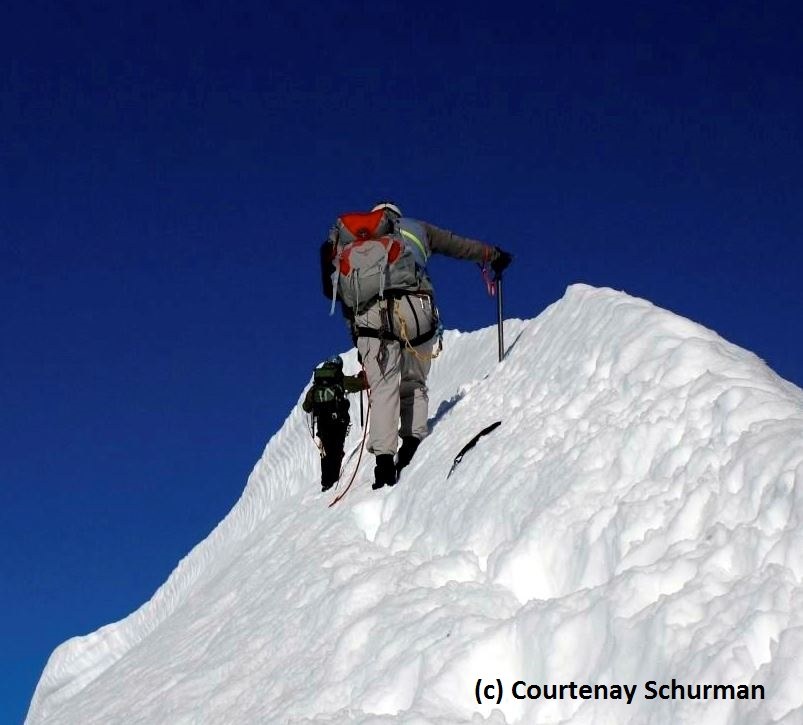
Eldorado Peak, Aug 23-24
[Climb Leader]
On August 24, our team had an accident at the base of the Eldorado glacier during the descent from Eldorado Peak. Thanks to a great team work, and a good amount of luck, we were able to continue to the TH without assistance.
The accident happened on the second day of a two-day climb. Following a long day, we reached the summit on the evening of August 23. After a full night’s sleep we began the descent around 8am the next morning. The team was well-rested, and the conditions were excellent.
We dropped ropes and harnesses at the base of the glacier and scrambled down slabs interrupted by some snow fields. The team was mostly travelling together. On the final stretch of slabs, two students decided to scramble down a more difficult section while the rest of the group scrambled down steps to the side. A rope lead and I asked the two students to watch for slippery sections and to turn around if they did not feel secure.
The first student made it down without incident. The second climbing student decided to move to an easier route. During the debrief, she said that she felt she had good traction.
However, she suddenly hit a wet spot, lost her footing, and began sliding down the slab. From below, a rope lead and I were able to see her path down the slab: she slid approximately 10 yards down a slope of approximately 30 degrees. She was not able to arrest her slide, but naturally came to a stop on a 1.5-foot ledge. This was approximately 5 yards before a 2-yard drop onto slab sloping approximately 15-20 degrees.
Because our fallen climber was in obvious pain, one student and I approached her on a safe path. We made sure that she was in a stable position and tried to calm her down. Her right shoulder was clearly dislocated. We failed to check her for other injuries, but they seemed unlikely given the slow speed of her slide. We removed her backpack and passed it down to other party members on the lower slab. We used a single runner as a sling to immobilize her arm and we fit her with a harness. We chose an alpine bod as this seemed easiest to fit on her in this location.
Meanwhile, a rope lead built an anchor around a large, secure boulder. I double-checked the belay anchor. After tying our injured climber into the belay rope, a rope leader slowly lowered our injured climber onto the lower slab.
We chose a path off the direct fall line to minimize the step between the upper and lower slabs. A student guided our injured climber through the step. The climber remained on belay and moved to a wide bench on the lower slab.
Once our injured climber was secure on the bench, we re-assessed her condition. She was clearly in serious pain and mobility was very limited. She is an MD/Ph.D. student and was the only party member with medical training. However, I had previously experienced the same anterior shoulder dislocation the injured climber was suffering from. On that occasion, my shoulder was reset (reduced) by a shoulder surgeon met coincidentally on the hike out.
I talked the injured climber through the steps and the sensations she could expect during the reduction based on my own experience with the same injury. With her permission, I reduced her shoulder in three steps, with our injured climbing guiding me during the shoulder reduction.
When the procedure was completed, her pain was mostly gone. After a short time, she felt well enough to continue the descent. Meanwhile, the other students distributed the contents of our injured climber's backpack. Our injured climber chose to take a light pack in order to give her shoulder some stability. Approximately 90 minutes passed between the accident and our departure from the scene.
The two rope leads moved ahead to set up a belay rope for the gully while the rest of the team carefully continued the descent down the remaining slabs and across a boulder field. One person walked directly in front of the injured climber at all times. Once the team arrived at the gully, the rope leads directed traffic to permit other groups to descend the gully. When the path was clear, we place our injured climber on belay and she down-climbed the gully with ease.
The team then continued down to the cars. The remainder of the descent was uneventful. Our injured climber was very strong and sure-footed. We arrived at the cars by 3pm.
[Our Party Debrief]
We then had a debriefing during dinner at Mondos in Marblemount. The general opinion was that the situation was dealt with calmly and efficiently. The team reached the following observations conclusions during the debriefing:
- Be extra cautious on slabs and consider the consequences of a fall (run-out)
- Rescuers safety goes first to prevent further injuries
- There was no official role distribution in our team, the trip leader and a rope lead naturally became the leads of the rescue
- We failed to check for further injuries, but they were rather unlikely due to the slow speed of her slide
- Teamwork was excellent and made our response fast and efficient
- We could have improved communication between rescuers and the rest of the team -part of the team was not sure what had happened
- Physical fitness leaves reserves to cope with unexpected situations
- We were lucky that one party member has had personal experience with this kind of injury. The outcome of the trip would have been very different otherwise.
 David Shema
David Shema